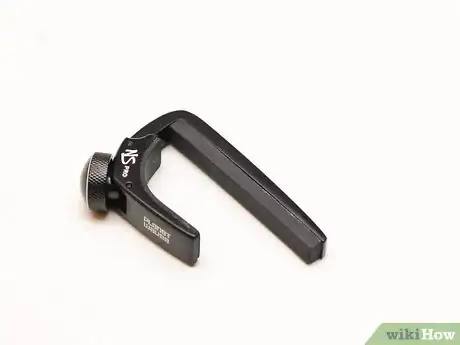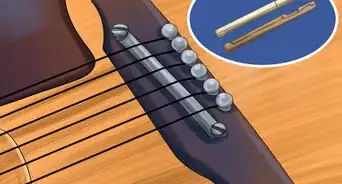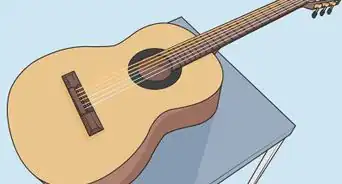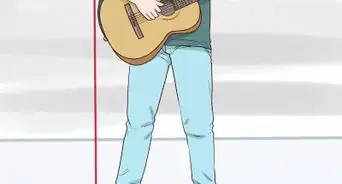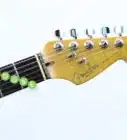This article was co-authored by Aaron Asghari. Aaron Asghari is a Professional Guitarist and the lead guitarist of The Ghost Next Door. He received his degree in Guitar Performance from the Guitar Institute of Technology program in Los Angeles. In addition to writing and performing with The Ghost Next Door, he is the founder and primary guitar instructor of Asghari Guitar Lessons.
There are 9 references cited in this article, which can be found at the bottom of the page.
wikiHow marks an article as reader-approved once it receives enough positive feedback. In this case, 93% of readers who voted found the article helpful, earning it our reader-approved status.
This article has been viewed 177,656 times.
A guitar capo is a device used by many guitarists to easily raise the pitch of their guitar. It works by clamping the strings down on a given fret, which changes the key. Say you know a song in only one key – playing with a capo will allow you to play the original chords of the song and have those chords sound like they're in a higher key. Capos are used by both beginners and advanced players. Some assume they are a beginner's tool, but capos actually expand the possibilities of the guitar, making them popular amongst veteran players.
Steps
Choosing a Capo
-
1Use a trigger capo. Trigger capos work by using a spring-loaded clamp to hold their tension. This clamp is simply is squeezed to open and close the capo. Players like trigger capos because they can be quickly and easily repositioned using just one hand, making them great for live performances.[1]
- This is the recommended type of capo for beginners, as it is simple and easy to use.
-
2Try using a screw capo if you want greater control over your capo's pressure against the strings. Screw capos work using an adjustable knob that can be screwed to your desired amount of pressure. The downfall about screw capos is their impracticality – it's hard to do a live show when you have to keep screwing and unscrewing your capo in place. However, these capos are sometimes preferred when recording music because of the amount of control they give the guitar player.[2]Advertisement
-
3Buy a Shubb capo. This design combines the speed of a trigger capo with the precision of a screw capo. Shubb capos use a simple lever, which can be adjusted for tension, and can easily be flipped on or off. Though they’re more expensive than the previous capos mentioned, they are very popular amongst seasoned guitar players.
-
4Invest in a premium capo. The G7th performance capos have become a favorite amongst many guitar players, as they are gentle, practical, and give the player great control. These capos allow for easy tension adjustment – all you need to do is squeeze it down over the desired location, and the G7th performance capo automatically locks in place. To release the capo, all you have to do is flip a lever.[3]
- Some reviews claim that this capo is actually better at preserving the tone of your guitar as well.
Putting a Capo on Your Guitar
-
1Hold your guitar and capo in the proper position. Set your guitar on your lap, or place it around your shoulders using your guitar strap. You should position your guitar how you would typically play it, even if you were not using a capo. Hold your capo in your fretting hand so you can easily clip it in place.
-
2Place your capo on the desired fret. Using a capo raises the key one half-step for every fret. If you place the capo on the first fret, the new key will be one half-step higher. If you place the capo on the second fret, the new key will be two half-steps higher. This continues with every fret.[4]
- For a specific example, let's use a standard E tuning. Say you've placed a capo on the third fret. The E strings become Gs (three half steps higher in pitch than E). All the strings become three half steps higher in pitch once the capo is applied — B becomes D; G becomes Bb; D becomes F; and A becomes C. [5]
- If you're reading a tab sheet, the tab will typically tell you which fret to place your capo on.[6] (Example: Capo 4, meaning capo on the fourth fret).
-
3Open the capo and clamp it down in the fret, slightly behind the fret bar. There are a few kinds of capos that operate slightly differently, though they essentially do the same thing. All have two thick rubber paddings that clamp down on the strings of your guitar. The longer side of the capo that comes in contact with the strings is the front. The back of the capo is usually shorter and clamps down on the back of the guitar neck.[7]
-
4Place your capo properly on the neck of your guitar. If you place your capo on the wrong part of your guitar, it can easily become out of tune. The capo should be placed in the fret, just behind the fret bar. Do not leave a large space between the capo and the fret bar, but don't place it directly on top of the fret bar either.
- If you place the capo too far back in the fret, it may cause your guitar to go sharp.[8]
Playing With a Capo
-
1Play below the capo. Once you place a capo on your guitar, only the strings below the capo will be in the new raised key. The section below the capo is the part of the neck closer to the body of your guitar. The section above the capo is the part of the neck closer to the head and tuning pegs of the guitar. Be sure to only play below the capo once you've placed it on your guitar.[9]
- All of the chords you play below the capo will sound like they're in a higher key. Play the chords as you normally would.
-
2Use your capo in a live performance. Many guitarists choose to clip their capo on the head of their guitar during a live performance so that it is easily accessible throughout their show. This allows the guitarist to easily use the capo for some songs and take it back off for others.
-
3Find the best key for a singer. All voices are different, so the original keys of some songs may not be a fit for every singer. Capos come in handy when you have to find a new key of a song for a singer. Using a capo will allow you to play the song in the new key without having to learn entirely new chords.[10]
-
4Use a capo to get a different timbre. A guitar capo can do much more than simply change the key of a song, it can create an entirely different sonic experience. For example, playing in the key of A with and without a capo will have entirely different feels even though you're playing in the same key, so experiment with your capo to hear the differences. Essentially, you'll be using different voicing to play the same chords, which produce entirely different sounds.
Expert Q&A
-
QuestionIs using a capo cheating?
 Aaron AsghariAaron Asghari is a Professional Guitarist and the lead guitarist of The Ghost Next Door. He received his degree in Guitar Performance from the Guitar Institute of Technology program in Los Angeles. In addition to writing and performing with The Ghost Next Door, he is the founder and primary guitar instructor of Asghari Guitar Lessons.
Aaron AsghariAaron Asghari is a Professional Guitarist and the lead guitarist of The Ghost Next Door. He received his degree in Guitar Performance from the Guitar Institute of Technology program in Los Angeles. In addition to writing and performing with The Ghost Next Door, he is the founder and primary guitar instructor of Asghari Guitar Lessons.
Professional Guitar Player Not at all. A capo just lets you quickly adjust the key of a song while still using the same guitar chord shapes and scale patterns.
Not at all. A capo just lets you quickly adjust the key of a song while still using the same guitar chord shapes and scale patterns. -
QuestionHow can I lessen the pain in my fingers?
 Community AnswerTry lessening the pressure you apply when you play. Otherwise, just practicing continually over time will allow calluses to form on your fingers that will stop them from hurting.
Community AnswerTry lessening the pressure you apply when you play. Otherwise, just practicing continually over time will allow calluses to form on your fingers that will stop them from hurting. -
QuestionDoes it matter which way up I have my capo?
 Community AnswerIt depends on the capo, but it doesn't ordinarily matter.
Community AnswerIt depends on the capo, but it doesn't ordinarily matter.
Things You'll Need
- An acoustic guitar
- A capo
- A pick (optional)
References
- ↑ http://ehomerecordingstudio.com/best-guitar-capos/
- ↑ http://ehomerecordingstudio.com/best-guitar-capos/
- ↑ http://www.g7th.com/choosing-a-capo.aspx
- ↑ http://www.guitaradventures.com/ultimate-guitar-capo-guide
- ↑ http://www.dummies.com/how-to/content/how-to-use-a-capo-on-guitar.html
- ↑ http://www.dummies.com/how-to/content/how-to-use-a-capo-on-guitar.html
- ↑ http://www.cyberfret.com/misc-wisdom/capo/page2.php
- ↑ http://www.destinyguitar.com/destinyguitar/capo-how-to-capo.html
- ↑ https://www.guitarlessonworld.com/lessons/parts-guitar-learn-guitars-anatomy/
About This Article
Using a capo is an easy way to raise the pitch of your acoustic guitar. To put a capo on, first, open it by squeezing the 2 handles together. Place the longer arm just above one of the frets with the handles pointing up. When you let go, the capo should gently clamp down and cover all the strings of your guitar. The higher you place the capo on your guitar, the higher the pitch of your stings will be. To learn how to adjust your capo for your singing range, read more from our Music co-author!

